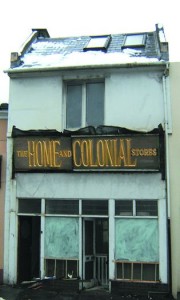Home & Colonial Stores Sign Exposed
Builders working at 102 Bohemia Road in January exposed a Home and Colonial Stores’ gold-lettered fascia board.
The letters seemed unnaturally bright considering the many years they’d been covered up – had real gold been used?
The 1968 Kelly’s Street Directory lists the shop. Terry Foord of Munday’s said that the manager then was Robert Crouch. By 1974, the shop is no longer listed in Kelly’s.
Cllr Andrew Cartwright asked Borough Planning Officer Tim Cookson if the sign should be preserved. Tim said “We do not consider that the property is a candidate for being Listed even with the recently exposed sign. Planning control could not require the owners to retain the sign”.
COMMENTS
- Ion Castro writes (Apr 2010) Dear Sir, the tale of the Home and Colonial sign [Voice 73 and pictured ] interested me because I remember collecting OXO tins from that very shop in the 1950’s when, as a child, I lived in Blomfield Road (these tins had a ‘second life’ as lunch boxes and were also ideal for the hoarding of small items so important to children – including odd little items purchased from ‘The Magic Shop’). My mother would give me the penny ha’penny trolleybus fare from Magdalen Road to the Wheatsheaf (Service 6 or the less frequent service 2) so that I could go shopping for her in establishments including the Home and Colonial, vegetables from Jim Samson in the ‘Warrior Stores’ and groceries from Grooms both on the other side of the road, or bread and cakes from Borgeauds next to ‘The Prince Of Wales’ (now the Labour Party HQ). Oddly enough I didn’t go into Henry King & Feaist – now the Village Voice office – (must have been something to do with the free ‘stale cakes’ from Borgeauds). I don’t know if your readers are aware how signs like the one at the Home and Colonial were made and the reason that it has remained so bright – the lettering was cut into a backboard (which is what remains now), usually wood, and then gilded with real gold leaf. The whole sign was then faced with glass, carefully painted on the inside, usually in black for dramatic effect – and the signage lining up with the backboard allowing the incised lettering to show through. This technique afforded tremendous protection from the elements to the sign and required very little maintenance. Ion Castro, 119 Braybrooke Road, Sunny Hastings.
- Peter Lennard writes (Apr 2010) Dear Sir, most interesting, that fascia found like that. These were typical “state-of-the-art” Victorian shop signs, with gilded lettering on a black background, and a plate glass cover. They would last for ever and be very visible, making all the other ‘old-fashioned’ hand painted ones look pale and unnoticeable in comparison. As modern in its time as a neon sign or a LED sign, and they were everywhere at the time. Hopefully this one can be carefully, restored, and saved for display elsewhere or in a museum. Peter Lennard RIBA.
- Hastings Museum has agreed to take the sign – ed.
Leave a Response
You must be logged in to post a comment.


